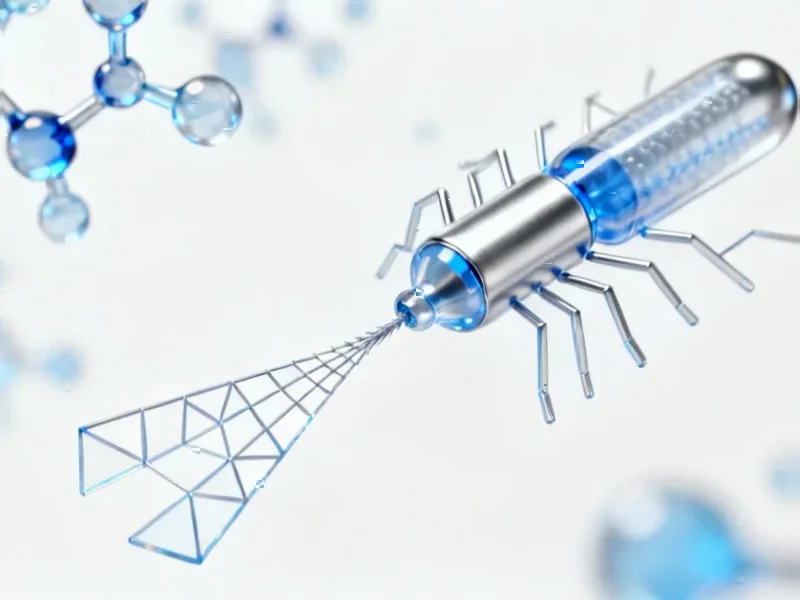According to Phys.org, scientists at UC San Diego’s Scripps Institution of Oceanography have developed a revolutionary method to produce xanthommatin, the natural pigment behind octopus and squid camouflage, achieving production levels up to 1,000 times greater than traditional methods. The breakthrough, published in Nature Biotechnology, involved creating a “growth coupled biosynthesis” system where genetically engineered bacteria must produce the pigment to survive, yielding 1-3 grams per liter compared to the typical 5 milligrams. Led by marine chemist Bradley Moore and former postdoctoral researcher Leah Bushin, the team used robotic evolution and custom bioinformatics to optimize production, with the approach potentially applicable to many other chemicals beyond just this pigment. This development marks a significant step toward sustainable, nature-based alternatives to fossil fuel-derived materials.
The Materials Revolution Nobody Saw Coming
This breakthrough represents more than just scientific curiosity—it’s a potential market disruptor that could reshape multiple industries simultaneously. The ability to produce xanthommatin at scale addresses what has been a fundamental bottleneck in biomimetic materials development. For decades, researchers have understood the theoretical potential of biological compounds like this pigment, but the practical limitations of extraction and synthesis made commercial applications economically unviable. Now, with production costs potentially dropping by orders of magnitude, we’re looking at a scenario where nature’s most sophisticated optical technologies become commercially accessible.
Stealth Technology’s Next Evolution
The immediate interest from the U.S. Department of Defense shouldn’t surprise anyone familiar with the military’s long-standing fascination with cephalopod camouflage. What makes this particularly compelling is that we’re not just talking about simple color matching—xanthommatin-based systems could enable dynamic camouflage that adapts to changing environments in real-time. Unlike current stealth technologies that primarily address radar signatures, this approach could create surfaces that actively blend with visual backgrounds, potentially revolutionizing everything from vehicle coatings to personnel gear. The timing is particularly significant given increasing investment in adaptive materials across defense sectors globally.
The Sustainable Beauty Revolution
For the cosmetics industry, this breakthrough arrives at a perfect moment. Consumer demand for natural, sustainable ingredients has been accelerating, while regulatory pressure on synthetic chemicals continues to mount. Xanthommatin’s potential as a natural UV protectant could position it as a premium alternative to controversial synthetic sunscreens like oxybenzone, which faces increasing restrictions due to environmental concerns. More importantly, the pigment’s dynamic color properties could enable entirely new categories of adaptive cosmetics—products that adjust to lighting conditions or skin tones in ways previously impossible with static pigments.
A New Paradigm in Biomanufacturing
The methodology itself may prove more valuable than the specific pigment it produces. The “growth coupled biosynthesis” approach represents a fundamental shift in how we approach biological manufacturing. Traditional metabolic engineering often struggles with yield limitations because cells naturally resist diverting resources to non-essential functions. By making production essential for survival, the UC San Diego team has essentially hacked cellular economics. This same principle could be applied to countless other valuable compounds, potentially accelerating the transition from petrochemical-based manufacturing to biologically-derived alternatives across pharmaceuticals, materials, and specialty chemicals.
Winners and Losers in the Coming Shift
The ripple effects of this technology will create clear market winners and losers. Companies specializing in synthetic dyes, pigments, and specialty chemicals face potential disruption as biologically-derived alternatives become cost-competitive. Meanwhile, biotechnology firms with expertise in metabolic engineering and fermentation processes stand to gain significantly. The cosmetics industry’s embrace of this technology could create a new premium segment for adaptive, natural products, while traditional sunscreen manufacturers may need to rapidly adapt or risk being left behind. The timing is particularly challenging for companies heavily invested in synthetic chemistry approaches who now face both regulatory headwinds and technological disruption simultaneously.
The Green Chemistry Dividend
Perhaps the most significant long-term impact lies in sustainability. Traditional pigment and dye manufacturing often involves hazardous chemicals, heavy metal catalysts, and energy-intensive processes. Biological production using engineered microorganisms offers a dramatically cleaner alternative with lower environmental footprint. As Moore noted, this approach supports “rethinking how we make materials” for a population of 8 billion people. The timing aligns perfectly with growing regulatory pressure on industrial chemicals and increasing consumer demand for truly sustainable products—not just greenwashed versions of existing technologies.
The Road to Commercialization
Despite the exciting potential, significant challenges remain before we see xanthommatin-based products on shelves. Scaling from laboratory success to industrial production always presents unexpected hurdles, particularly with biological systems where consistency and contamination control become major concerns. Regulatory approval pathways for novel biological materials can be lengthy and uncertain, especially for applications like cosmetics and sunscreens that involve direct human contact. Intellectual property positioning will also be crucial—while the specific pigment occurs naturally, the production methodology and specific formulations will likely become fiercely contested territory as companies recognize the commercial potential.




